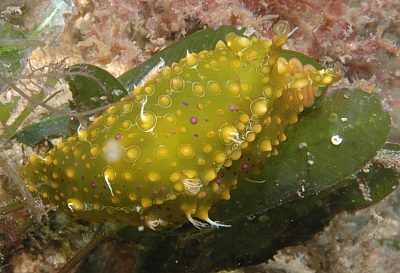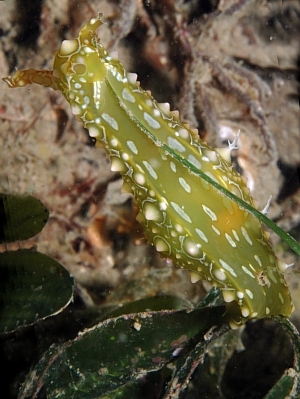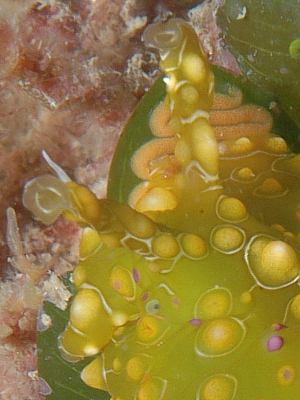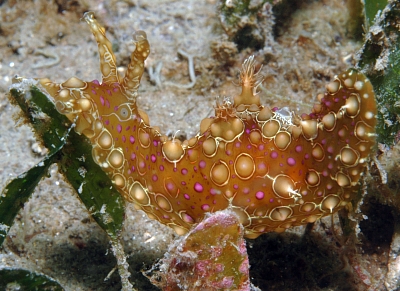Re: Petalifera ramosa with probable eggs
November 30, 2007
From: Leanne & David Atkinson

Concerning message #21206:
Dear Bill,
We found what we think is Petalifera ramosa laying eggs. If you look carefully you can see the start of an orange zigzag of eggs under its mouth. It was one of those photos that we didn't see what was going on until we put it on the computer screen. This Petalifera ramosa was hunched up so it didn't make a good shot and there were lots of others that looked like better photos to the naked eye. Because the egg laying wasn't particularly clear we didn't send it in earlier, thought it may have just been crawling over them. But we thought after seeing Ron Greer's shot with more detail that we should send it in as support to the theory that these are the type of eggs it lays. Now we know what we are looking for it will help. Mating photos show the head of one on the back of the head of another. Where do they lay eggs them from?
Locality: Fly Point, Port Stephens - Great Lakes Marine Park, Port Stephens, 8 metres, New South Wales, Australia, Pacific, 10 November 2007, Sandy bottom with scattered sponges, ascidians, kelp and seagrass. Length: approximately 70 mm. Photographer: Leanne & David Atkinson.
We've also included two other Petalifera ramosa photos showing them moving over seagrass. We wondered if they were feeding on the growth on the seagrass. These were taken on the 3rd November 2007 at The Pipeline, Port Stephens, New South Wales in 8 metres with water temperature 17 degrees celcius.
Thankyou as always for the wonderful work that you do on the forum we enjoy learning about these beautiful creatures.
Best wishes,
Leanne & David Atkinson
atk@hunterlink.net.au



Dear Leanne & David Atkinson,
Thanks for these photos. The upper photo showing the egg ribbon on a blade of Halophila [see middle right close-up] certainly lends support to the idea that it is its egg ribbon. Your question about how they lay the egg ribbon raises an interesting question. Firstly I need to explain a little anatomy. In Petalifera the typical sea hare parapodia [see mantle cavity page] are partly fused together but there is a dorsal gap that can open a bit. You can see the gap in the upper photo in my message recording an animal from Lifou [#3687].
Now to mating and egg laying: Sea Hares, like all sea slugs, are hermaphrodites, but the penis is quite separate from the female openings. The penis is contained in a sac on the right side of the head while the female openings are situated at the front end of the parapodial cavity. Have a look at the drawing of the parapodial cavity of Stylocheilus [#7872], which is quite similar. I haven't got the reproductive openings labelled in that drawing but the black spot just in front of the parapodial cavity is the common genital opening and the curved line running forward to the right rhinophore represents an open groove down which the sperm is moved to the penis. So during mating the 'male' partner has to put the right side of its head near the common genital opening for copulation to occur.
How is the egg ribbon deposited? The egg ribbon is extruded from the common genital opening but I don't know how it is manipulated and attached in such a tight arrangement. In Sea Hares the tangled spaghetti-like tangle suggests that not much manipulation takes place but with Petalifera I suspect that like many nudibranchs, the ribbon is manipulated by the foot. If in your photo the egg ribbon is in the process of being deposited it would suggest that the head may wave back and forward to produce the zig-zag pattern. In Beeman's paper on Phyllaplysia taylori, which I mentioned in Ron Greer's message, the egg string is extruded from the common genital opening and then travels down the external sperm groove to the right side of the head where it is held by the lips and oral lappets and pressed to the substrate. The animal then moves its head from side to side to fasten the ribbon in the characteristic pattern. I think we can assume that Petalifera does exactly the same, but it would be worth adding it to your 'things to do' list, just to be sure.
Thanks for the question - if you hadn't asked I wouldn't have checked Robert Beeman's paper and found how they do it.
Best wishes,
Bill Rudman
Related messages
-
Re: Petalifera ramosa with probable eggs [2]
From: David and Leanne Atkinson, January 12, 2009 -
Re: Petalifera ramosa with probable eggs [1]
From: Leanne & David Atkinson, January 12, 2009 -
Re: Petalifera ramosa with probable eggs
From: Leanne & David Atkinson, February 1, 2008 -
Petalifera ramosa with probable eggs
From: Ron Greer, November 29, 2007 -
Petalifera ramosa mating?
From: Leanne & David Atkinson, November 1, 2007 -
Petalifera ramosa and its papillae
From: Leanne & David Atkinson, May 10, 2006 -
Petalifera ramosa from the Caribbean
From: Les Wilk, November 4, 2005 -
Petalifera ramosa from Port Stephens, NSW
From: Bruce Potter, November 2, 2005 -
Petalifera ramosa? from Eilat, Red Sea
From: Binyamin Koretz, May 11, 2005 -
Re: sea hare eggs
From: Binyamin Koretz, May 11, 2005 -
Petalifera ramosa from Saba,
From: Kelly Griggs, January 27, 2005 -
Petalifera ramosa from Bahamas
From: Lindsay Warren, March 23, 2004 -
Petalifera ramosa from Brunswick Heads
From: Denis Riek, December 19, 2003 -
Petalifera ramosa from Jamaica
From: Ross W. Gundersen, October 19, 2003 -
Petalifera ramosa from the Dominican Republic
From: Elianny Dominguez, May 17, 2003 -
Petalifera ramosa from the Caribbean
From: Bill Rudman, April 3, 2003 -
Petalifera ramosa from the Bahamas
From: Colin Redfern, April 2, 2003 -
Petalifera ramosa Baba from Japan
From: Jun Imamoto, February 5, 2003 -
Petalifera ramosa on Sea Grass
From: Erwin Koehler, February 8, 2001 -
Re: Petalifera from Pemba Island
From: Ron Velarde, February 7, 2001 -
Petalifera from Pemba Island
From: Bernard Picton, February 4, 2001 -
Petalifera ramosa from Lifou
From: Bill Rudman, February 4, 2001 -
Petalifera ramosa - additional images
From: Ron Greer, May 19, 2000 -
Re: Petalifera ramosa from New South Wales
From: Ron Greer, December 7, 1999 -
Petalifera ramosa from New South Wales
From: Ron Greer, December 3, 1999
